Measure to Measure - Page 6
The Volume FunctionWe have graphed Volume vs. Mass and Cut vs. Surface Area - let's graph Cut vs. Volume. Perhaps we will be able to determine the cut that gives us the largest possible volume. Can you predict what that cut will be?
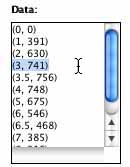
Enter the data into the
Data Flyer.
Use ordered pairs again, with x as the cut and y as the volume. For
example, our first box, with the cut of 3, had a volume of 741 units
cubed.  The ordered pair in this case would be (3, 741). Enter in
the rest of the data. After clicking "Auto Window," click "Plot
Data." What are your observations?
The ordered pair in this case would be (3, 741). Enter in
the rest of the data. After clicking "Auto Window," click "Plot
Data." What are your observations?
Cut vs. Volume
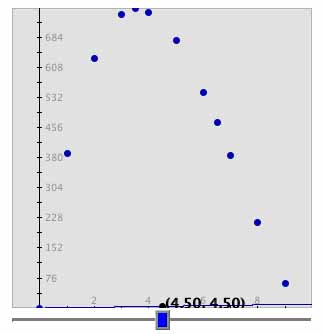
This graph appears to curve like the Cut vs. Surface Area graph. Therefore a line would not be the best fit. We need to find another equation to fit the data like we did for the Cut vs. Surface Area graph. We found the original volume equation using the Volume Applet. The volume can also be found using a Volume Formula that simply multiplies length * width * height. However, because length, width and height all depend upon the size of cut we choose, the formula quickly gets complicated and requires the use of algebra.
The equation that we will use for volume is
y= 475x - 88x2 + 4x3.
 On the Data Flyer, where it says "y=" type in "475*x-88*x^2+4*x^3".
Then click "Set Function."
On the Data Flyer, where it says "y=" type in "475*x-88*x^2+4*x^3".
Then click "Set Function."
Alternatively you can type in the formula "(25-2*x)*(19-2*x)*x", which is the same function without the algebra multiplication. Make sure to include the parentheses!
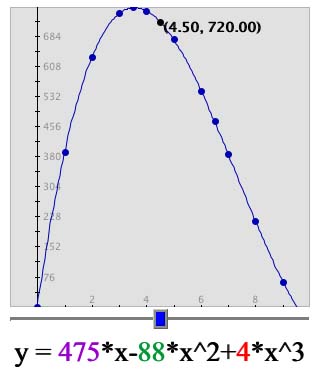
What does the graph look like? Notice how the graph increases
and then decreases. This is a non-linear graph, in other words, it
does NOT look like a line. It resembles a parabola like the Cut vs. Surface
Area graph, but it is slightly different.
We cannot see the whole shape of the graph from this view.
Zoom out a little by
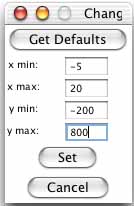 clicking on "Set Window..." and change
"x min:" to -5, "x max:" to 20, "y min:" to -200, and
"y max:" to 800.
clicking on "Set Window..." and change
"x min:" to -5, "x max:" to 20, "y min:" to -200, and
"y max:" to 800.
 Then click "Set." What do you notice about
the graph now?
Then click "Set." What do you notice about
the graph now?
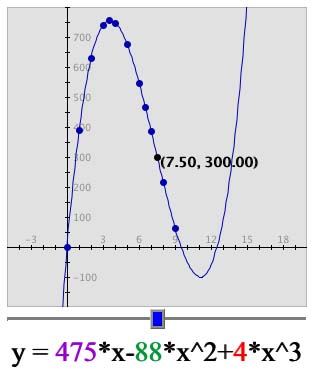
In this graph the function appears to have both a high and a low point - this is a common characteristic of a cubic function and is an expected result, since we were working with volume, which is in cubic units. Like the surface area function, the volume function includes values that we will not consider because they are not in the real-life domain, or the limits for the x-values(the cuts). Scientists would say that the function "is only valid over a particular domain". Limit that domain!
The optimal volume is the biggest one, so try to find the maximum value. Move the blue slider box from left to right until you find the largest y-value (the second one in the ordered pair, remember?). What is the x-value (cut) that corresponds with that y-value (volume)?
Be careful, is the cut a valid one? Note that just because the function gives larger volume values on the right side doesn't mean that we can actually make cuts that big. What would happen, for example, if you tried to make a cut of say, 15 units? The maximum volume is just over 756 cubic units. What valid cut will give you that volume? What invalid cut does the function say would give you that volume?
Many relationships in science can be described with mathematical functions, and it is the job of the scientist to be able to take data and recognize patterns that might give a hint as to which kinds of functions best express the relationship. Once the function is known, it becomes possible to answer specific questions about the relationship - like which values are the biggest or smallest. Finding these optimal values is what engineering is all about.
| Challenge problems |